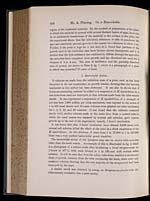Alexander Fleming (1881-1955)
On a remarkable bacteriolytic element found in tissues and secretions
308
Mr. A. Fleming. On a Remarkable
region of the implanted material. By the method of preparation of the plate,
in which the material is covered with several distinct layers of agar, there can
be no mechanical transference of the material to the surface of the plate, but
the experiment shows that the inhibitory substance is able to penetrate the
agar and absolutely prevent growth of the coccus for a distance of about 1 cm.
Further, if the plate is kept for a few days, it is found that portions of the
growth next to the inhibition zone have become almost transparent, and it is
evident that the lytic substance has continued to diffuse through the agar after
the microbes have completed their growth, and has dissolved the cocci for a
distance of 3 or 4 mm. The area of inhibition and the partially dissolved
zone of growth are shown in Plate 9, fig. 1, which is a photograph of a plate
in which was imbedded 10 c.mm. of tears.
2. Bactericidal Action.
If cultures are made from the inhibition zone of a plate, such as has been
described in the last experiment, no growth results, showing that the bacteria
implanted on this surface has been destroyed. It can also be shown that if
lysozyme-containing material be added to a suspension of M. lysodeikticus in a
test-tube these cocci are destroyed, so that cultures made from the tube remain
sterile. In one experiment a suspension of M. lysodeikticus, of a strength of
not less than. 1,000 million per cubic centimetre, was exposed to the action of
1 in 100 nasal mucus and 10 c.mm. volumes were planted out after incubation
for 1, 2, 5, 10, and 60 minutes. It was found that the cultures remained
sterile while similar cultures made at the same time from a control tube in
which the nasal mucus was replaced by normal salt solution, gave copious
growth up to the end of the experiment, namely, 1 hour’s incubation.
It was found that after 2 hours’ incubation tears diluted 9,000 times with
normal salt solution killed the whole of the cocci in a thick suspension of the
M. lysodeikticus. In the dilutions of tears from 1 in 27,000 to 1 in 243,000
there was a very marked bactericidal power manifest.
The bactericidal action of the lysozyme may also be shown with microbes
other than the nasal coccus. An example of this is illustrated in fig. 2, which
is a photograph of a culture made after incubating a fæcal streptococcus for
2 hours at 45° C., with tears diluted in 1 in 100 and with normal saline
solution. It will be seen that from the saline tube there resulted a continuous
sheet of growth, whereas, from the tube containing the tears, there were only
scattered colonies, showing that the vast majority of the streptococci had been
destroyed by the tears.
A similar result was obtained by acting on Streptococcus fæcalis with the
inflammatory exudation into a joint cavity.


